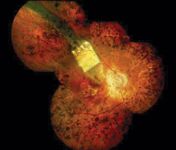Restoring sight to the blind
The high incidence of neurodegenerative retinal diseases that lead to visual impairment and blindness has given rise to new technological and biological advances in the field of ophthalmology. Electronic retinal prostheses are among the most eagerly anticipated, yet complex devices to be developed. The expertise of retinal specialists, surgeons and engineers has been combined to thoroughly research the effect of electrical stimulation on retinal neurons, to develop micro-electronic chips, investigate new encapsulation methods that are bio-compatible and to develop methods of powering the subretinal devices.

Unveiling the results
Professor Eberhart Zrenner, MD, led a clinical study with the SUBRET consortium to examine the efficacy and safety of subretinal implants and presented his results for the first time at the 2006 annual meeting of the Association for Research in Vision and Ophthalmology (ARVO) in Fort Lauderdale, Florida, USA, earlier this year.

Postoperative results showed that the implants were well tolerated, with no adverse events being reported and optical coherence tomography (OCT) images revealed stable retinal attachment in both patients. The implant was removed in one patient after four weeks, as per the study plan, while the other patient chose to leave the prosthesis implanted.
What does this meant for the patient?
The retinal prostheses can achieve a spatial resolution of 1° visual angle. This could represent a significant improvement in quality of life for patients by allowing them to orient themselves in space and to recognize and distinguish larger objects. The prostheses look to have a promising future, since the study revealed that the crucial elements of implantability, biocompatibility and spatial resolution were all successfully tested with positive results.
Having initiated the project back in 1995 and, during that time, co-founding the implant manufacturing company, Retina Implant AG, Dr Zrenner is now beginning to see the impact his research is having on the lives of others.
Can it be used for other conditions?
Retinitis pigmentosa is just one of the neurodegenerative retinal diseases for which these prostheses are geared. It is a hereditary progressive degeneration of the retina, which affects night vision as well as peripheral vision, slowly creating tunnel vision. The hallmark of the disease is the presence of dark pigmented spots on the retina, increasingly impairing vision as the disease progresses. The prostheses could also be employed for retinopathies such as cone-rod dystrophies or choroideremia.
Macular degeneration may be another area that would benefit from this approach. The condition is on the rise and is projected to become the single leading cause of legal blindness in a decade from now, occurring in as many as 5.5% of people over 65 years of age. Novel technological inventions such as subretinal prostheses are therefore necessary to counterbalance this rise in macular degenerative diseases, which more often than not will result in partial or complete blindness.
"From the positive results attained in this study, a chronic subretinal stimulation with the use of small electrodes enables a blind patient to successfully discriminate patterns of small, bright, steadily appearing dots. These consistent results were reliably repeated over weeks and demonstrated a still intact subretinal micro-electrode array, showing promise for restored sight in blind patients suffering from retinitis pigmentosa," Dr Zrenner affirmed.
